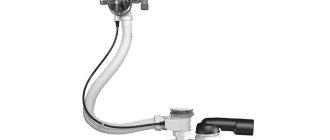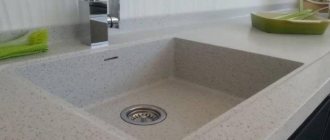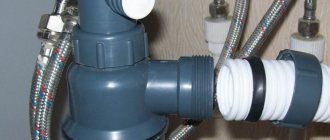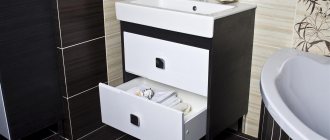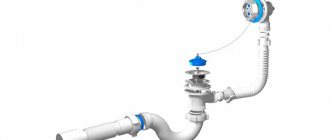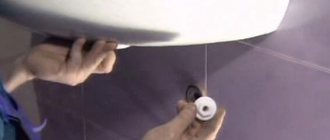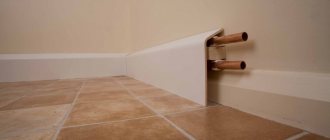Even if during the renovation process the sink in the kitchen or bathroom remains the same, then it is better to replace all communications that go to it. First of all, this applies to such a product as a siphon. The operation is quite simple, so you do not need to call a professional plumber. But to avoid unpleasant consequences, you should know how to assemble a sink siphon correctly.
Purpose of the siphon
Whether you live in a private house or in an apartment, if your home has a sink, washbasin, bathtub or shower, then there are siphons there. You can do without this plumbing device only in the case of an outdoor washbasin.
Siphon
A siphon is a curved section of pipe through which waste water is drained from a sink/bathtub/shower tray into the sewer system. Connecting a sink to a sewer is impossible without this plumbing fixture. After all, it is what retains unpleasant odors coming from the sewer pipe and prevents the growth of bacteria thanks to the water seal that it forms.
It is also necessary to connect a siphon to the sewer to catch coarse debris that, for whatever reason, ends up in the drain. It is important to immediately note that the plumbing device in question is not capable of fully protecting the sewer system from clogging. It is necessary to periodically use additional chemicals intended for drain cleaning.
Principle of operation
If you don’t go into too much detail and explain the principle of operation in simpler words, then it looks like this. The used water in the sink or sink passes through the water line outlet, enters the flask, passes through the settling pipes, and ends up in the sewer.
Provided that the installation work was carried out correctly, a water seal is formed in the device, preventing the unpleasant smell from the sewer from entering the living space. Unpleasant odors may arise if the plumbing fixtures have not been used for a certain period of time. However, they are easily eliminated by flushing the toilet or sink.
When assembling the structure, be sure to connect all its parts with rubber cone gaskets . They are the ones responsible for the quality of the work done and prevent leaks. Each gasket must have elasticity, and little effort is required to put it on the pipe. In case of installation with a poor-quality gasket, the possibility of disconnection of the product flask from the tube to which it is fixed with its help cannot be excluded.
Types of siphons
Before we begin to analyze the question of how to properly connect a siphon to a sink or other plumbing fixture, let’s look at what types of siphons exist. After all, having decided to purchase this product, you will first of all think about its variety, which is necessary specifically in your case. For greater clarity, consider the following images.
Types of siphons
As can be seen from the above pictures, the most functional and easy to install today is the bottle siphon. We will stop there.
Material of manufacture
The corrugated siphon is made only of elastic plastic. All others can be made from the following materials:
- plastic - the main difference is low price, but the service life of the siphon is much shorter;
- cast iron - used in Soviet times, now practically not used;
- metal (copper, brass, stainless steel) – a metal siphon is distinguished by its high price and long service life, ease of maintenance, resistance to household chemicals, etc.
Basic equipment of a bottle siphon
To answer the question of how to install a bottle siphon on a sink, you must first consider what parts it consists of. The main components of a bottle siphon for a sink or bath are:
- protective grille;
- set of rubber gaskets;
- conical rubber cuffs;
- inlet or outlet pipe;
- connecting screw;
- coupling nut;
- bottom;
- connecting nut for sewer pipe;
- drain pipe.
Basic equipment
What should be included?
Before purchasing a suitable model, you should make sure that it is fully equipped. The following details must be present:
- metal threaded insert in the outlet tube, with a seal;
- two plastic nuts (possible diameters 32,40 and 50 mm, these dimensions apply to the next two components);
- cone-shaped gasket;
- cuff with plastic skirt;
- device body;
- bottom cover with seal;
- sewer outlet (in the form of a corrugated tube, flexible hose, rigid plastic pipe);
- several drain elements: a stainless screw (for fixation), a decorative cover, a gasket (made of silicone or durable rubber), a rubber plug, a protective grille.
Various modifications of bottle siphons
Depending on your device model, it may have additional parts such as:
- several inlet pipes;
- overflow pipe;
- auto drain valve.
If you will have a washing machine next to the sink on which you are installing the siphon, you should consider purchasing a model with a special additional inlet pipe. It is much easier and more convenient to connect household appliances to the sewer through a siphon, rather than directly.
The overflow pipe is installed on a sink, the design of which initially includes an overflow hole. To avoid flooding in the kitchen, manufacturers of bathroom and kitchen sinks have recently begun to equip them with an overflow hole, and manufacturers of siphons have begun to equip their products with an overflow pipe.
Siphon with overflow
Auto-draining is a very convenient feature of modern models. When there is a need to fill the sink with water, just simply press to close the valve on the drain. Then, when you no longer need the water in the sink, the valve opens and the drainage continues as usual.
Auto drain
The image below shows one of the modifications of the bottle siphon. In general, they all have a similar device, but which modification of the siphon for the bathroom sink to choose is up to you to decide based on your specific conditions.
Siphon with stopper
There are also models of siphons for double sinks. The convenience of this model is that you do not have to install the sink siphon twice. And this will significantly save your time and effort. But not only. The model with two inlet pipes is more compact, which is important for productive use of the space under the sink. By installing 2 separate siphons on a double-bowl sink, you create a web of pipes and hoses under the sink. This will not only prevent you from placing a trash can there, for example, but will also make the sewer unit difficult to maintain.
Siphon for double sink
Device selection
When choosing a siphon for a sink, you must consider the following parameters:
- Size - depends on the free space in the sink; if there is not enough space, you can buy a special, flat siphon.
- Diameter of pipes.
- Complete set - pipes, gaskets, etc.
- Quality - the surface must be free of chips, cracks, burrs, etc.
- Manufacturer - the price range depends on this.
| Model | Viega Siphon | Vitra Syphone | Vitra Syphone | Viega Siphon | AlcaPlast | AlcaPlast |
| A country | Germany | Türkiye | Türkiye | Germany | Czech | Czech |
| View | Bottle | Bottle | Tubular | Tubular | Bottle | Tubular |
| Cost, rub.) | 150 | 280 | 350 | 620 | 300 | 420 |
Summarize
Assembling a siphon for a sink, washbasin, shower cabin or bathtub does not take much time and does not require special skills. However, there are a number of nuances that you should be aware of and take into account so that you do not have to do double work by redoing something. You need to take everything into account so that you don’t soon need to replace a completely new device with a more functional model, because you forgot to take into account that you will place a washing machine nearby and it will also need to be connected to the sewer through a siphon.
If you are new to plumbing and are installing a siphon for the first time, the manufacturer’s instructions for the product may be incomprehensible in some ways. Having only a schematic description of the assembly and installation sequence of the device, it does not contain important information and tips that will help you avoid mistakes and protect your kitchen from sewer leaks.
Useful tips
The following tips will help you operate the drainage device without any problems:
- When installing a siphon, it is necessary to ensure that the drain grate is symmetrically positioned relative to the sink opening.
- The device is cleaned by supplying hot water, which dissolves fat deposits well. To speed up the process, use soda or special detergents. They are poured into the hole, and then the water is intensively drained, washing.
- The use of a plunger allows you to periodically clean the device without disassembling the sump.
- Thread sealing does not ensure tight connections. Rubber gaskets provide reliable protection against leaks. When worn, they should be replaced.
- It is not recommended to pour overly contaminated liquids into the sink. A fine strainer is installed at the outlet, which should be cleaned periodically.
Preparing for replacement
Scheme of a siphon with drain.
Before buying a new siphon, be sure to measure the diameter of the spout of your existing plumbing product. It is desirable that the new siphon has the same fit.
If you cannot find a suitable product, you will have to buy a transition cuff. You can also buy a special siphon with a stepped spout end; it fits all 3 sizes. You will need to trim off the excess and buy the lower seal separately.
Immediately buy a sealing collar along with the siphon. Check its strength and elasticity, see how it will sit on the spout. Avoid purchasing a siphon that has large burrs on the spout trim. They will interfere with seating the cuff. Such a defect indicates low quality of the raw materials.
The entire preparatory stage boils down to dismantling the installed product and mandatory cleaning of the sewer pipe.
When cleaning, you don’t have to try too hard: the cuff is designed to be secured in a rough socket.
Some difficulties may arise if a Soviet-made cast iron product embedded in a pipe with cement mortar is being replaced. Then you will need to arm yourself with a chisel and a small hammer. Only with their help will it be possible to get rid of old cast iron and clean the pipe from cement residues. At the same time, it is important to ensure that no cement fragments remain in the pipe, because in the future they will constantly lead to the formation of blockages. You can remove debris using pliers or tweezers.

